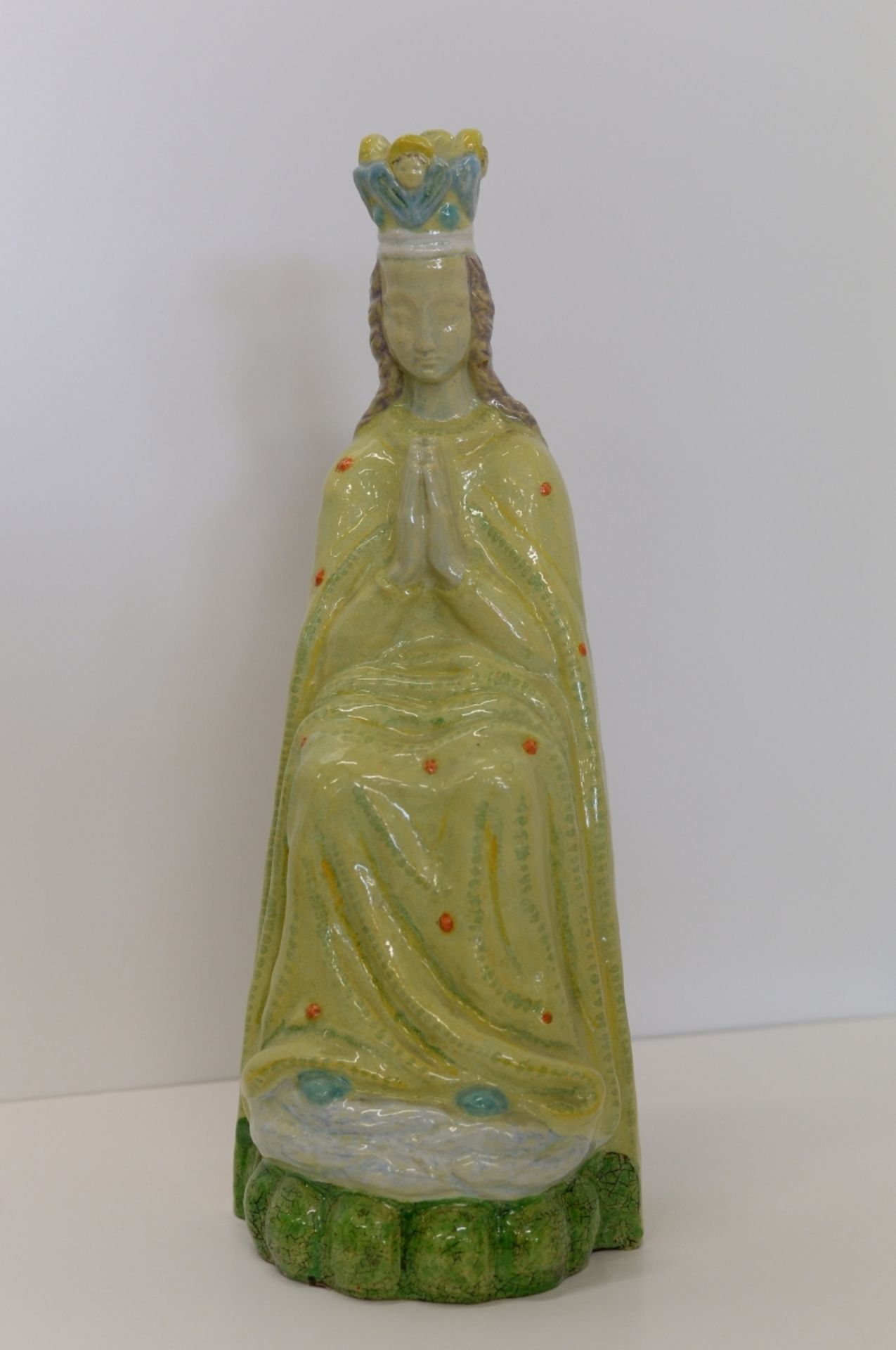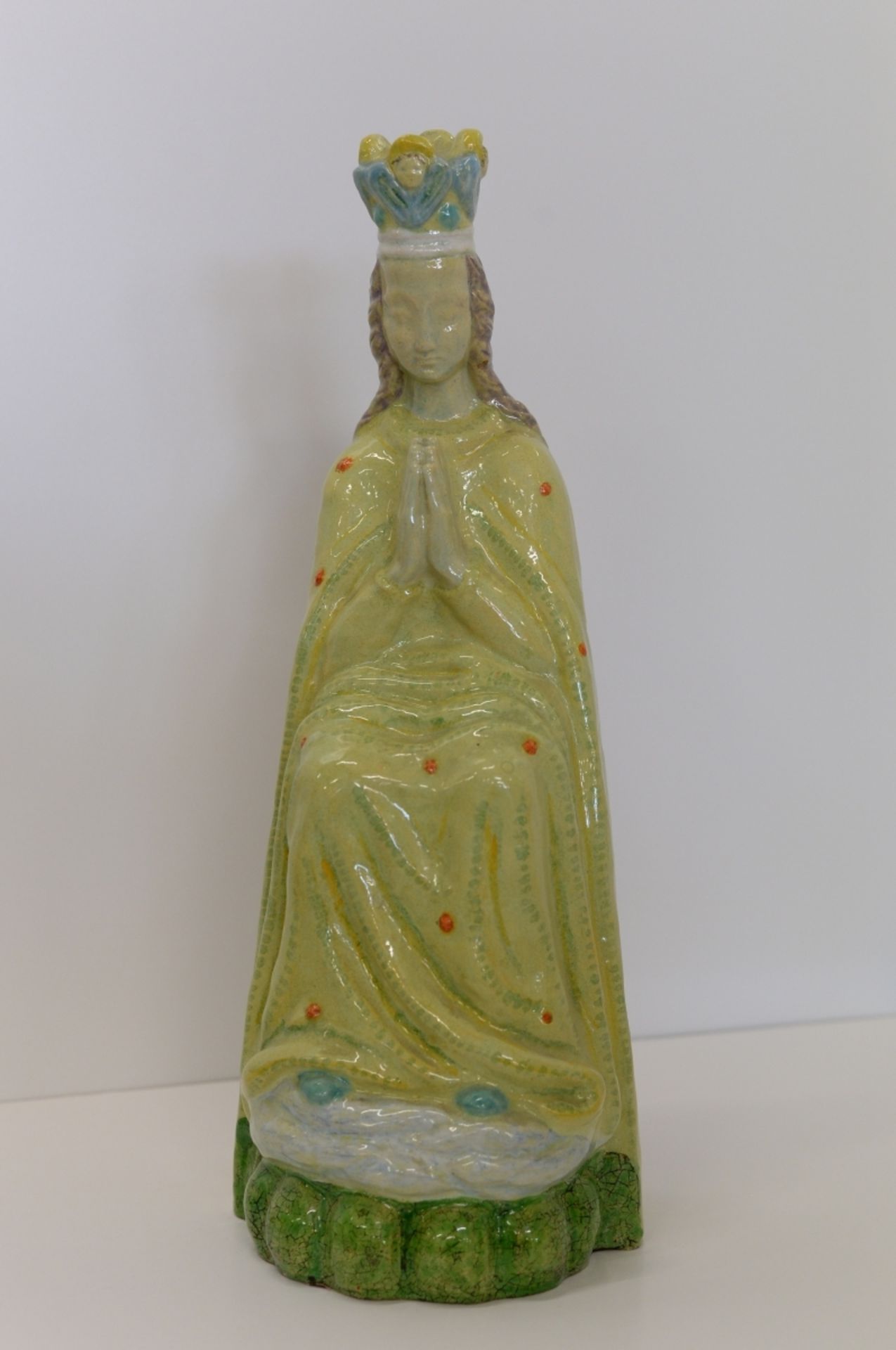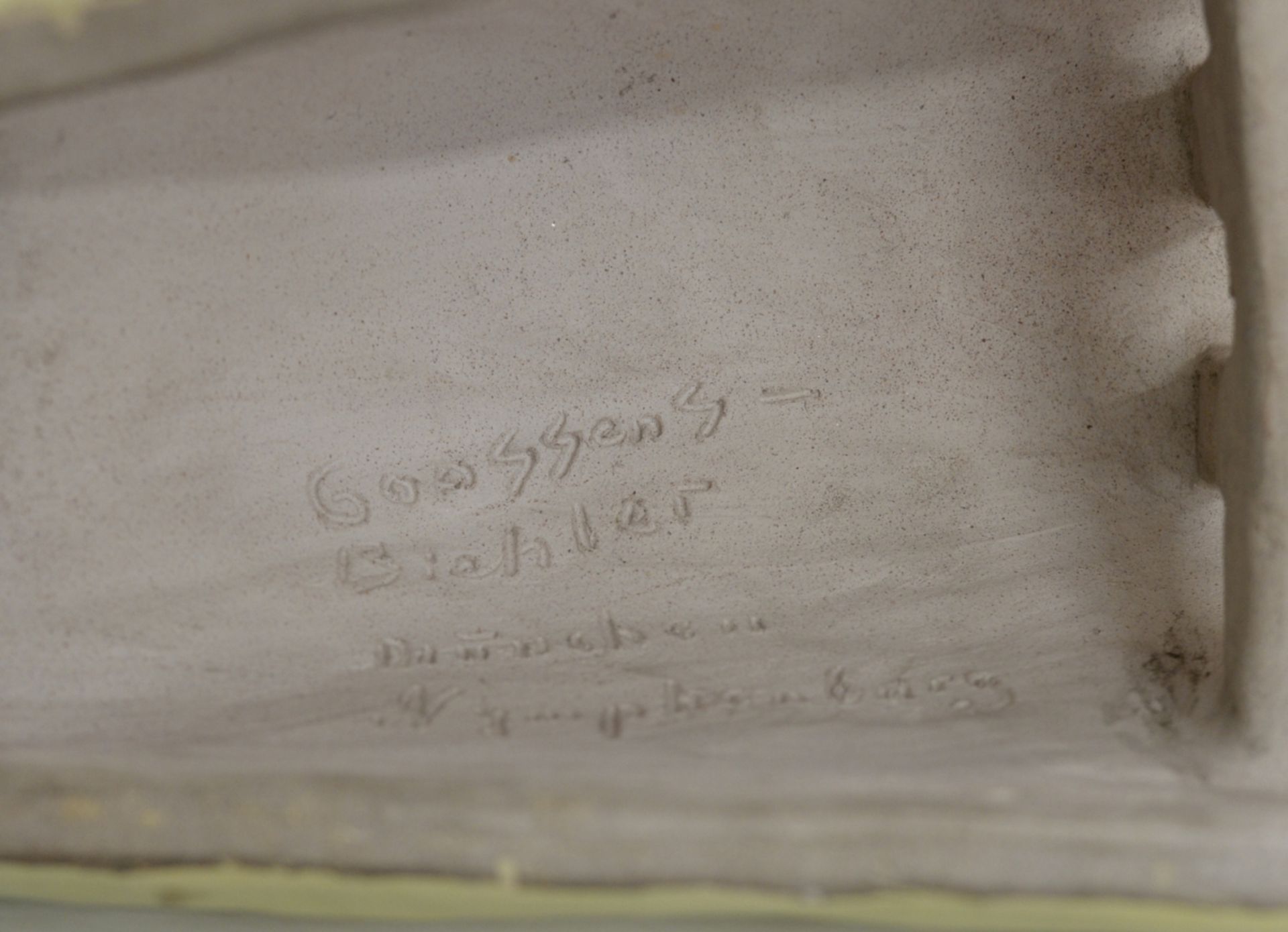59
Hermine GOOSENS (1879-1967) und Johanna BIEHLER (1880-1954)
Hermine GOOSENS (1879-1967) und Johanna BIEHLER (1880-1954)
Thronende Madonna
Seltene Keramik aus der Majolika-Werkstatt Nymphenburg, kurz nach 1900, 56 cm hoch
Hermine Goossens, allgemein bekannt als "Minnie Goossens", stammte aus einer in Aachen ansässigen Fabrikantenfamilie. Im Umfeld der Münchener Debschitz-Schule lernte Goossens die Künstlerin Johanna Biehler (1880-1954) kennen, mit der sie gemeinsam im Jahr 1903 eine eigene Majolika-Manufaktur in Nymphenburg gründete. Während sich Goossens schwerpunktmäßig auf den Entwurf, die Modellierung und die plastische Gestaltung der Majolika-Werke und Großmedaillons konzentrierte, übernahm Biehler vor allem die Herstellungstechnik und die künstlerische Farbgestaltung, wobei sie im Besonderen mit den Scharffeuerfarben experimentierte und dazu neue Mischungen und Lasuren herstellte und erprobte.Das Künstlerpaar Goossens/Biehler wurde schnell in der Kunstszene bekannt und geschätzt und ihre Reliefs, Fliesen und Medaillons wurden von zahlreichen Baumeistern und Architekten in Privatvillen und Repräsentationsgebäuden als Hausschmuckobjekte zur Fassaden-, Portal-, Treppenhaus- und Wandgestaltung verwendet. Dabei legten sie Wert darauf, ausschließlich Unikate zu kreieren, die nur in ihrer keramischen Werkstatt hergestellt wurden und lehnten folglich mehrere Übernahmeangebote von Fabriken ab, die ihre Gegenstände in industrieller Serienanfertigung herstellen wollten.
Hermine GOOSENS (1879-1967) and Johanna BIEHLER (1880-1954), Enthroned Madonna, rare ceramic from the Majolika-Werkstatt Nymphenburg, shortly after 1900, 56 cm high // Hermine Goossens came from a family of manufacturers based in Aachen. In the surroundings of the Debschitz School in Munich, Goossens met the artist Johanna Biehler (1880-1954), with whom she founded the majolica factory in Nymphenburg in 1903. While Goossens focused on the design, modeling and plastic design of the majolica works and large medallions, Biehler mainly took over production technology and artistic color design, experimenting in particular with sharper colours and producing and testing new mixtures and varnishes. The artist couple Goossens/Biehler quickly became known and appreciated in the art scene and their reliefs, tiles and medallions were used by numerous builders and architects in private villas and representative buildings as home decor objects for facade, portal, staircase and wall design. They considered to create only unique items that were only produced in their ceramic workshop and therefore rejected several takeover offers from factories that wanted to manufacture their items in industrial series production.
Hermine GOOSENS (1879-1967) and Johanna BIEHLER (1880-1954), Enthroned Madonna, rare
ceramic from the Majolika-Werkstatt Nymphenburg, shortly after 1900, 56 cm high // Hermine
Goossens came from a family of manufacturers based in Aachen. In the surroundings of the
Debschitz School in Munich, Goossens met the artist Johanna Biehler (1880-1954), with whom
she founded the majolica factory in Nymphenburg in 1903. While Goossens focused on the
design, modeling and plastic design of the majolica works and large medallions, Biehler
mainly took over production technology and artistic color design, experimenting in
particular with sharper colours and producing and testing new mixtures and varnishes. The
artist couple Goossens/Biehler quickly became known and appreciated in the art scene and
their reliefs, tiles and medallions were used by numerous builders and architects in
private villas and representative buildings as home decor objects for facade, portal,
staircase and wall design. They considered to create only unique items that were only
produced in their ceramic workshop and therefore rejected several takeover offers from
factories that wanted to manufacture their items in industrial series production.
Hermine GOOSENS (1879-1967) und Johanna BIEHLER (1880-1954)
Thronende Madonna
Seltene Keramik aus der Majolika-Werkstatt Nymphenburg, kurz nach 1900, 56 cm hoch
Hermine Goossens, allgemein bekannt als "Minnie Goossens", stammte aus einer in Aachen ansässigen Fabrikantenfamilie. Im Umfeld der Münchener Debschitz-Schule lernte Goossens die Künstlerin Johanna Biehler (1880-1954) kennen, mit der sie gemeinsam im Jahr 1903 eine eigene Majolika-Manufaktur in Nymphenburg gründete. Während sich Goossens schwerpunktmäßig auf den Entwurf, die Modellierung und die plastische Gestaltung der Majolika-Werke und Großmedaillons konzentrierte, übernahm Biehler vor allem die Herstellungstechnik und die künstlerische Farbgestaltung, wobei sie im Besonderen mit den Scharffeuerfarben experimentierte und dazu neue Mischungen und Lasuren herstellte und erprobte.Das Künstlerpaar Goossens/Biehler wurde schnell in der Kunstszene bekannt und geschätzt und ihre Reliefs, Fliesen und Medaillons wurden von zahlreichen Baumeistern und Architekten in Privatvillen und Repräsentationsgebäuden als Hausschmuckobjekte zur Fassaden-, Portal-, Treppenhaus- und Wandgestaltung verwendet. Dabei legten sie Wert darauf, ausschließlich Unikate zu kreieren, die nur in ihrer keramischen Werkstatt hergestellt wurden und lehnten folglich mehrere Übernahmeangebote von Fabriken ab, die ihre Gegenstände in industrieller Serienanfertigung herstellen wollten.
Hermine GOOSENS (1879-1967) and Johanna BIEHLER (1880-1954), Enthroned Madonna, rare ceramic from the Majolika-Werkstatt Nymphenburg, shortly after 1900, 56 cm high // Hermine Goossens came from a family of manufacturers based in Aachen. In the surroundings of the Debschitz School in Munich, Goossens met the artist Johanna Biehler (1880-1954), with whom she founded the majolica factory in Nymphenburg in 1903. While Goossens focused on the design, modeling and plastic design of the majolica works and large medallions, Biehler mainly took over production technology and artistic color design, experimenting in particular with sharper colours and producing and testing new mixtures and varnishes. The artist couple Goossens/Biehler quickly became known and appreciated in the art scene and their reliefs, tiles and medallions were used by numerous builders and architects in private villas and representative buildings as home decor objects for facade, portal, staircase and wall design. They considered to create only unique items that were only produced in their ceramic workshop and therefore rejected several takeover offers from factories that wanted to manufacture their items in industrial series production.
Hermine GOOSENS (1879-1967) and Johanna BIEHLER (1880-1954), Enthroned Madonna, rare
ceramic from the Majolika-Werkstatt Nymphenburg, shortly after 1900, 56 cm high // Hermine
Goossens came from a family of manufacturers based in Aachen. In the surroundings of the
Debschitz School in Munich, Goossens met the artist Johanna Biehler (1880-1954), with whom
she founded the majolica factory in Nymphenburg in 1903. While Goossens focused on the
design, modeling and plastic design of the majolica works and large medallions, Biehler
mainly took over production technology and artistic color design, experimenting in
particular with sharper colours and producing and testing new mixtures and varnishes. The
artist couple Goossens/Biehler quickly became known and appreciated in the art scene and
their reliefs, tiles and medallions were used by numerous builders and architects in
private villas and representative buildings as home decor objects for facade, portal,
staircase and wall design. They considered to create only unique items that were only
produced in their ceramic workshop and therefore rejected several takeover offers from
factories that wanted to manufacture their items in industrial series production.
WEIHNACHTSAUKTION
Auktionsdatum
Ort der Versteigerung
Für Galerie Moenius Versandinformtation bitte wählen Sie +41 (0)31 8324753.
Wichtige Informationen
Zu Aufgeld und Mehrwertsteuer prüfen Sie bitte das jeweilige Los.
For buyer’s premium and VAT please check particular lot.
AGB
auto AH | auto AH
1. Basics:
Galerie Moenius AG auctions items/objects on behalf, in the name and for the account of a third party (the supplier remains unknown). Prices in the catalogue are estimated prices only. The call price is the lower estimated asking price. Currency is Swiss Franc (CHF) only. The highest bidder (accepted by the auctioneer) receives the acceptance of the bid. Once a bid is accepted, the guarantee obligation of Galerie Moenius AG shall be dissolved. The Bidder shall only receive the auctioned object(s) after complete payment of the full amount in cash, via confirmed bank transfer or credit card. Bidder cards can be charged 4 days after an invoice has been sent. The auction will be accompanied by a notary from the Canton of Berne, who will draw up a record of the results and decide immediately and definitively on any disputes concerning bids, surcharges or the course of the auction.
2. Payment:
Beside the price for the acceptance of the bid, the buyer has to pay the premium of 23%. In case of a "Live Auction" (online bidding in real time) the auctioneer is entitled to a surcharge of 3% or 5% of the price for the acceptance of the bid.
At a Live Auction the Swiss VAT (value added tax) of 7.7% will be added to the premium and the surcharge (if applicable). Buyers who file their papers in due and proper form will be able to get a full refund of the VAT (an officially stamped export declaration is necessary).
If the bidder wants to pay via credit-card 3% of the total-amount will be charged. Bidder cards can be charged 4 days after an invoice has been sent.
The bidder agrees that the auctioneer receives a premium from the seller/supplier.
In case of late-/non payment by the bidder, Galerie Moenius AG has the full debt collection rights and is allowed to transfer these rights to a 3rd party agency.
Invoices issued during or immediately after the auction must be verified; errors remain reserved to this extent.
Important: Cash payments are limited to CHF 10.000,00 (ten thousand) only.
The addressee of the invoice must be the forwarder of the bank transfer.
3. Warranty:
The objects to be auctioned are used. Their condition is not documented. The objects can be seen and examined on site before the auction starts. They are auctioned in the state they are at the acceptance of the bid. Descriptions and images in the catalogue were prepared in Galerie Moenius AG's best knowledge and belief, but meant for information only. Potential buyers are required to request a condition report for every work of art. This report expresses Galerie Moenius subjective assessment only. Galerie Moenius AG assumes no liability for details in the catalogue or for the condition report.
In case of forgery after 1900 (year), being proven as such by a majority of experts, Galerie Moenius AG will take the item/object back within 8 weeks after end of auction, on its own will and with no legal consequences, and will reimburse price of acceptance, the premium and VAT.
The origin, material and time data for the items in the categories Asia, Ancient Art (Antiquity) and Africa are taken from the former invoices or certificates. Galerie Moenius AG accepts no liability for this information.
4. Auction Participants:
In order to receive an auction ID number, every bidder needs to submit her/his personal data. Bidders who are not known personally need to obtain an official ID card. Galerie Moenius AG may request bank references and securities such as a credit card. All bids are considered "in the name and account" of the registered bidder only. If a bidder wants to act on behalf of a 3rd party, he must submit an authorized, written authorisation of such 3rd party not later than 24hrs before the beginning of the auction. The representative, together with the representee is both individually and legally responsible for their bidding. Galerie Moenius AG may at its own discretion deny a person attendance of the auction and/or access to their offices.
5. Auction:
Galerie Moenius AG reserves the right to alter catalogue numbers or change/combine/withdraw them in the auction. The acceptance of the bid might be accepted or denied under reserve. The auctioneer can cancel the acceptance of a bid if an offer has been overlooked or if there is a dispute about the acceptance of the bid. The object/item can be auctioned again.
Submitting a bid is a firm offer to buy. Unless a bid is over-/underbid it is bounded. If a bid is accepted under reserve it stays firm for 14 days. Double-bids will be objected and will be re-auctioned immediately. If several bidders make the same offer, the item/object is assigned by lot, written offers have priority. If double-bids occur via phone, the bidder present at the auction will get the acceptance. In case of doubt the auction management has the right to decide. There is no right for the acceptance of a bid. Galerie Moenius AG excludes any liability for non considered bids of any kind or non received telephone bids.
6. Pick Up and Shipment
Successfully auctioned items/objects need to be picked-up by the bidder within 14 days. During or immediately after the auction, successfully auctioned items/objects can only be pick-up after full payment is received, either in cash, via confirmed bank transfer or with a cashier's check. Cash payments are limited to CHF 10.000,00 (ten thousand) only. Invoices might be revised. Errors are excepted.
Galerie Moenius AG assumes liability for damage, destruction or theft of fully paid items/object for 14 days, limited to the amount of the accepted bid, premium and Swiss Vat. After this period Galerie Moenius AG assumes no liability, the buyer needs to get an appropriate insurance then. In general Galerie Moenius AG is not liable for damages on frame or glass.
Shipment can`t be arranged, but Galerie Moenius will recommend a shipper. A liability for transport damages or loss is rejected
7. Miscellaneous
Galerie Moenius AG may publish and use auction results and images. Images of items/objects may be used for advertising purposes by Galerie Moenius AG.
Only Swiss law is applicable.
Should any individual provisions of these terms be or become invalid in part or in their entirety, this shall not impair the validity of all the other provisions. Changes of the auction's terms and condition need to be submitted in written form, oral agreements are not valid.
Location of the auction is the offices of Galerie Moenius AG, Bollst. 61, CH-3076 Worb.
Place of execution and sole jurisdiction is Bern.










